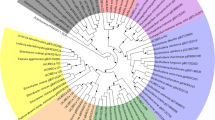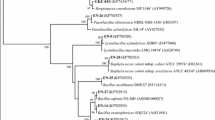Abstract
Three plant-growth-promoting isolates of endophytic bacteria from sugar beet roots produced indole-3-acetic acid (IAA) in vitro in a chemically defined medium. The three isolates were selected from 221 endophytic bacteria isolated from surface-disinfected beet roots and evaluated for potential to produce IAA and to promote beet growth under gnotobiotic and glasshouse conditions. The inoculation of roots of beet by three selected bacteria isolates significantly increased plant height fresh and dry weights and number of leaves per plant, as well as levels (p < 0.01) of phytormones compared with control plants. In the glasshouse test, the three selected bacterial isolates were recovered from inside roots in all samplings, up to 8 weeks after inoculation, indicating that the roots of healthy beet may be a habitat for these endophytic bacteria.


Similar content being viewed by others
References
Akello J, Dubois T, Coyne D, Kyamanywa S (2008) Effect of endophytic Beauveria bassiana on populations of the banana weevil, Cosmopolites sordidus, and their damage in tissue-cultured banana plants. Entomol Exp Appl 129:157–165. doi:10.1111/j.1570-7458.2008.00759.x
Aravind R, Kumar A, Eapen SJ, Ramana KV (2009) Endophytic bacterial flora in root and stem tissues of black pepper (Piper nigrum L.) genotype: isolation, identification and evaluation against Phytophthora capsici. Lett Appl Microbiol 48:58–64. doi:10.1111/j.1472-765X.2008.02486.x
Bacon CW, Hinton DM (2002) Endophytic and biological control potential of Bacillus mojavensis and related species. Biol Control 23:274–284. doi:10.1006/bcon.2001.1016
Barretti PB, De Souza RM, Pozza AAA, Pozza EA, De Carvalho JG, De Souza JT (2008) Increased nutritional efficiency of tomato plants inoculated with growth-promoting endophytic bacteria. Rev Bras Cienc Do Solo 32:1541–1548. doi:10.1590/S0100-06832008000400018
Bhuvaneswari V, Kathiravan G, Gangadevi V, Muthumary J (2006) Extraction and estimation of indo, E-3-acetic acid (IAA) from some endophytic and pathogenic coelomycetes. Asian J Microbiol Biotechnol Environ Sci 8:243–248
Bressan W, Borges MT (2004) Delivery methods for introducing endophytic bacteria into maize. BioControl 49:315–322. doi:10.1023/B:BICO.0000025372.51658.93
Caitriona D, Wilson LW, McFadden H (2004) Gene expression profile changes in cotton root and hypocotyl tissues in response to infection with Fusarium oxysporum f. sp. vasinfectum. Mol Plant Microbe Interact 17:654–667. doi:10.1094/MPMI.2004.17.6.654
Cleland RE (1990) Auxin and cell elongation. In: Davies PJ (ed) Plant hormones and their role in plant growth and development. Kluwer, Dordrecht, pp 132–148
Dai C, Yu B, Xu Z, Yuan S (2003) Effect of environmental factors on the growth and fatty acid composition of five endophytic fungi from Sapium sebiferum. Chin J Appl Ecol 14:1525–1528
Dai CC, Yu BY, Li X (2008) Screening of endophytic fungi that promote the growth of Euphorbia pekinensis. Afr J Biotechnol 7:3505–3510
El-Tarabily KA, Nassar AH, Hardy GESJ, Sivasithamparam K (2009) Plant growth promotion and biological control of Pythium aphanidermatum, a pathogen of cucumber, by endophytic actinomycetes. J Appl Microbiol 106:13–26. doi:10.1111/j.1365-2672.2008.03926.x
Frankenberger WT Jr, Poth M (1987) Biosynthesis of indole-3-acetic acid by the pine ectomycorrhizal fungus, Pisolithus tinctorius. Appl Environ Microbiol 53:2908–2913
Garrity GM, Holt JG (2001) The road map to the manual. In: Boone DR, Castenholz RW, Garrity GM (eds) Bergey's manual of systematic bacteriology, vol 1, Secondth edn. Springer, New York, pp 119–166
Gordon SA, Weber RP (1951) Colorimetric estimation of indole acetic acid. Plant Physiol 26:192–195. doi:10.1104/pp. 26.1.192
Guinn G, Brummett DL, Beier RC (1986) Purification and measurement of abscisic acid and indole-acetic acid by high performance liquid chromatography. Plant Physiol 81:997–1002. doi:10.1104/pp. 81.4.997
Halda-Alija L, Johnston TC (1999) Diversity of culturable heterotrophic aerobic bacteria in pristine stream bed sediments. Can J Microbiol 45:879–884. doi:10.1139/cjm-45-10-879
Harish S, Kavino M, Kumar N, Saravanakumar D, Soorianathasundaram K, Samiyappan R (2008) Biohardening with plant growth promoting rhizosphere and endophytic bacteria induces systemic resistance against banana bunchy top virus. Appl Soil Ecol 39:187–200. doi:10.1016/j.apsoil.2007.12.006
He H, Qiu SX, Cai XQ, Guan X, Hu FP (2004) Colonization in plants and identification of endophytic bacteria BS-1 and BS-2 from Capsicum annuum. Acta Microbiol Sin 44:13–18
Khalid A, Arshad M, Zahir ZA (2004) Screening plant growth-promoting rhizobacteria for improving growth and yield of wheat. J Appl Microbiol 96:473–480. doi:10.1046/j.1365-2672.2003.02161.x
Kodaka H, Mizuochi S, Teramura H, Nirazuka T (2005) Comparison of the compact dry IC method with the standard pour plate method (AOAC Official Method 966.23) for determining aerobic colony counts in food samples. J AOAC INtern 88:1702–1713
Lu H, Zou WX, Meng JC, Hu J, Tan RX (2000) New bioactive metabolites produced by Colletotrichum sp., an endophytic fungus in Artemisia annua. Plant Sci 151:67–73. doi:10.1016/S0168-9452(99)00199-5
Maria GL, Sridhar KR (2003) Endophytic fungal assemblage of two halophytes from west coast mangrove habitats, India. Czech Mycol 55:241–251
Matthews KR, Oliver SP, King SH (1990) Comparison of Vitek Gram-positive identification system with API Staph Trac system for species identification of staphylococci of bovine origin. J Clin Microbiol 28:1649–1651
Mayak S, Tirosh T, Glick BR (2004) Plant growth-promoting bacteria confer resistance in tomato plants to salt stress. Plant Physiol Biochem 42:565–572. doi:10.1016/j.plaphy.2004.05.009
Nejad P, Johnson PA (2000) Endophytic bacteria induce growth promotion and wilt disease suppression in oilseed rape and tomato. Biol Control 18:208–215. doi:10.1006/bcon.2000.0837
Patten CL, Glick BR (2002) Role of Pseudomonas putida indoleacetic acid in development of the host plant root system. Appl Environ Microbiol 68:3795–3801. doi:10.1128/AEM.68.8.3795-3801.2002
Rahman MH, Saiga S (2005) Endophytic fungi (Neotyphodium coenophialum) affect the growth and mineral uptake, transport and efficiency ratios in tall fescue (Festuca arundinacea). Plant Soil 272:163–171. doi:10.1007/s11104-004-4682-6
Raja P, Balachandar D, Sundaram SP (2008) Genetic diversity and phylogeny of punk-pigmented facultative methylotrophic bacterai isolated from the pjyllosphere of tropical plants. Biol Fertil Soils 45:45–53. doi:10.1007/s00374-008-0306-2
Sapak Z, Meon S, Ahmad ZAM (2008) Effect of endophytic bacteria on growth and suppression of Ganoderma infection in oil palm. Int J Agric Biol 10:127–132
Seyring M, Vogt G (2000) Influencing growth of endophytic bacteria and quality of shoots in plant tissue cultures of Argyranthemum frutescens. Gartenbauwissenschaf 65:115–120
Shin DS, Park MS, Jung S, Lee MS, Lee KH, Bae KS, Kim SB (2007) Plant growth-promoting potential of endophytic bacteria isolated from roots of coastal sand dune plants. J Microbiol Biotechnol 17:1361–1368
Taghavi S, Garafola C, Monchy S, Newman L, Hoffman A, Weyens N, Barac T, Vangronsveld J, Van Der Lelie DD (2009) Genome survey and characterization of endophytic bacteria exhibiting a beneficial effect on growth and development of poplar trees. Appl Environ Microbiol 75:748–757. doi:10.1128/AEM.02239-08
Ting ASY, Meon S, Kadir J, Radu S, Singh G (2008) Endophytic microorganisms as potential growth promoters of banana. BioControl 53:541–553. doi:10.1007/s10526-007-9093-1
Von Aderkasa P, Lelub MA, Labelb P (2001) Plant growth regulator levels during maturation of larch somatic embryos. Plant Physiol Biochem 39:495–502. doi:10.1016/S0981-9428(01)01271-2
Author information
Authors and Affiliations
Corresponding author
Rights and permissions
About this article
Cite this article
Shi, Y., Lou, K. & Li, C. Promotion of plant growth by phytohormone-producing endophytic microbes of sugar beet. Biol Fertil Soils 45, 645–653 (2009). https://doi.org/10.1007/s00374-009-0376-9
Received:
Revised:
Accepted:
Published:
Issue Date:
DOI: https://doi.org/10.1007/s00374-009-0376-9




